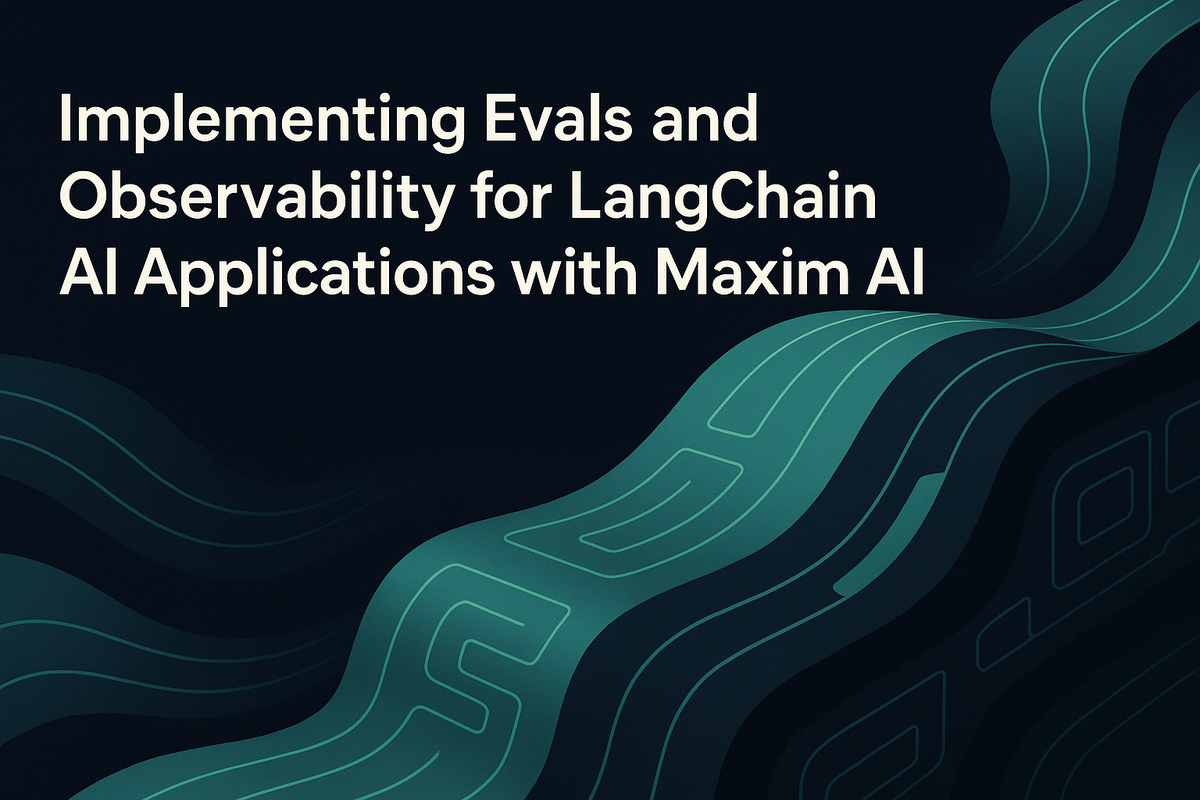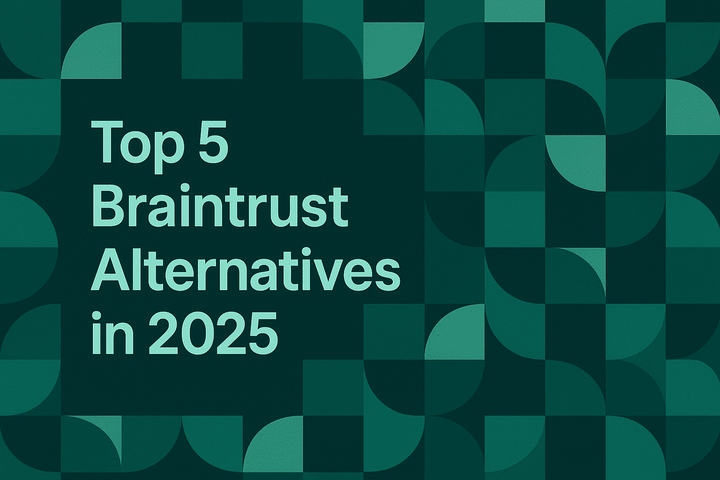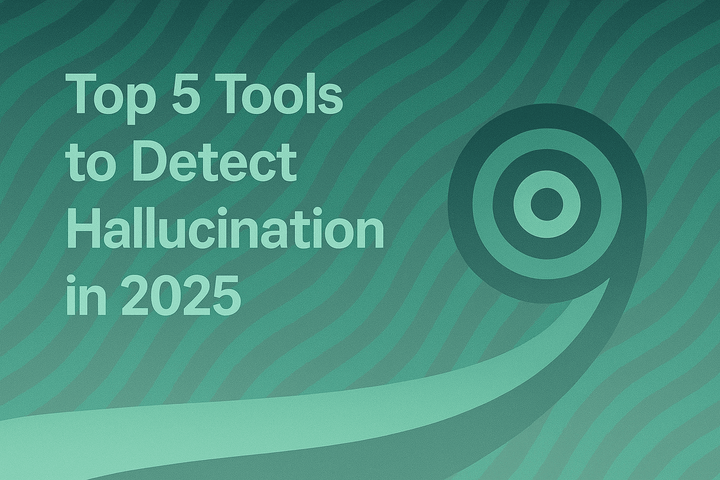Implementing Evals and Observability for LangChain AI Applications with Maxim AI

Building reliable AI applications requires robust observability and disciplined evaluation. When your agents and RAG pipelines run on LangChain, Maxim AI provides an end-to-end stack to trace every call, assess quality with machine and human evaluators, and continuously improve performance across cost, latency, and accuracy. This guide shows how to instrument a LangChain application with Maxim observability and implement evaluations that align to your business metrics, covering multimodal agents, RAG systems, and real-time voice experiences.
Why Observability and Evals Matter for LangChain Apps
LangChain offers a powerful abstraction to compose chains, tools, retrievers, and agents. But as complexity grows, teams need:
- Precise tracing to see each span, input/output, and intermediate state across runs.
- Concrete evals to quantify correctness, faithfulness, and other quality metrics.
- Production monitoring to catch regressions quickly and attribute issues to the right component.
Maxim AI’s observability and evaluation suite addresses these needs with an integrated lifecycle, Experimentation, Simulation, Evaluation, and Observability, so engineering and product teams can ship agents 5x faster and with greater quality. Explore the full capabilities on the product pages for Experimentation (Playground++), Agent Simulation & Evaluation, and Agent Observability.
Architecture Overview: LangChain + Maxim
At a high level:
- LangChain provides the application runtime and composition (models, tools, retrievers, agents).
- Maxim instruments your LangChain app via a tracer to capture distributed traces, token usage, cost, latency, errors, and outputs for analysis and debugging.
- Evals run against traces, datasets, or simulations with flexible evaluators (deterministic rules, statistical metrics, and LLM-as-a-judge), plus human-in-the-loop workflows.
For RAG systems, Maxim’s tracing helps observe retriever behavior, response quality, and citation coverage, helping teams tune prompts, indexing strategies, and ranking policies. For voice agents, Maxim supports streaming and real-time monitoring to track turn-level performance, interruptions, and ASR/NLG metrics.
Step-by-Step: Instrument LangChain with Maxim Observability
Follow this minimal integration to log models, messages, and spans with Maxim. It uses the LangChain OpenAI client and Maxim’s LangChain tracer.
- Install dependencies and set environment variables:
// requirements.txt
maxim-py
langchain-openai>=0.0.1
langchain
python-dotenv
// .env
MAXIM_LOG_REPO_ID=your_repo_id
OPENAI_API_KEY=your_openai_key
- Initialize the Maxim logger and LangChain tracer:
from maxim import Maxim, Config, LoggerConfig
from maxim.logger.langchain import MaximLangchainTracer
# Instantiate Maxim and create a logger (points logs to a specific repository)
logger = Maxim(Config()).logger(
LoggerConfig(id=MAXIM_LOG_REPO_ID)
)
# Create the LangChain-specific tracer
langchain_tracer = MaximLangchainTracer(logger)
- Make a basic LLM call with tracing:
from langchain_openai import ChatOpenAI
MODEL_NAME = "gpt-4o"
llm = ChatOpenAI(model=MODEL_NAME, api_key=OPENAI_API_KEY)
messages = [
("system", "You are a helpful assistant."),
("human", "Describe Big Bang theory")
]
response = llm.invoke(
messages,
config={"callbacks": [langchain_tracer]}
)
print(response.content)
- Enable streaming for voice or real-time experiences:
# Enable streaming
llm_stream = ChatOpenAI(
model=MODEL_NAME,
api_key=OPENAI_API_KEY,
streaming=True
)
response_text = ""
for chunk in llm_stream.stream(
messages,
config={"callbacks": [langchain_tracer]}
):
response_text += chunk.content
print("\\nFull response:", response_text)
After this setup, Maxim’s observability suite lets you inspect traces, spans, inputs/outputs, token counts, and errors; build custom dashboards; and attach automated evaluations to production logs. Learn more on the Agent Observability page.
For LangChain runtime concepts like callbacks and tracing, see the LangChain docs on callbacks and their broader Conceptual Guide: Tracing and Callbacks.
Implementing Evals: Deterministic, Statistical, and LLM-as-a-Judge
Maxim’s evaluation framework supports three complementary approaches:
- Deterministic evaluators: rule-based checks (e.g., JSON format validation, presence of required fields, forbidden phrases, or step-completion checks for multi-turn flows).
- Statistical evaluators: task-specific metrics (e.g., precision/recall for extraction, BLEU-like similarity for templated outputs, citation coverage for RAG).
- LLM-as-a-judge evaluators: rubric-driven graders leveraging strong models to approximate human preferences at scale.
Research shows LLM-as-a-judge can correlate strongly with human preference when carefully designed and controlled for biases. See “Judging LLM-as-a-Judge with MT-Bench and Chatbot Arena” for methods and limitations of LLM evaluators (arXiv:2306.05685). A broader perspective on reliability, bias mitigation, and benchmarking appears in “A Survey on LLM-as-a-Judge” (arXiv:2411.15594).
Maxim enables you to configure these evaluators at the session, trace, or span level. Product teams can run evals entirely from UI (Flexi Evals) while engineers can orchestrate them programmatically. Explore the evaluators and workflows on Agent Simulation & Evaluation.
Practical rubric design
For robust LLM-as-a-judge evals:
- Use clear, unambiguous rubrics aligned to your business outcomes (e.g., task completion, faithfulness, adherence to policies).
- Incorporate chain-of-thought suppression or structured reasoning prompts for judges to reduce verbosity bias.
- Include reference outputs when available to calibrate judges for correctness and specificity.
- Periodically calibrate with human reviews to validate judge reliability and reduce drift.
Maxim’s human-in-the-loop capabilities let you collect targeted reviews on contentious or high-value traces, improving evaluator alignment over time. See Agent Simulation & Evaluation for human annotation workflows.
RAG Tracing and Evaluation
RAG systems combine parametric models with non-parametric memory via retrieval. For these, observability must expose:
- Retriever query formation and filters.
- Retrieved document IDs, scores, and snippet content.
- Grounding quality and citation coverage in final answers.
The foundational paper on Retrieval-Augmented Generation is “Retrieval-Augmented Generation for Knowledge-Intensive NLP Tasks” (NeurIPS 2020; arXiv:2005.11401). In practice, teams should evaluate:
- Faithfulness: does the answer only use retrieved facts?
- Citation completeness: are relevant sources cited?
- Answer specificity: is the response precise rather than generic?
- Latency and cost trade-offs when increasing top-k or re-ranking.
Maxim’s distributed tracing and evaluators help you identify “lost in the middle” retrieval issues, prompt misalignment, or ranking regressions. Use Experimentation (Playground++) to iterate prompts and retriever parameters, then validate improvements at scale with simulation and evals.
Voice Agents: Streaming, Turn-Level Metrics, and Quality
For real-time voice assistants, observability must capture:
- Streaming tokens and partial outputs.
- Turn boundaries, interruptions, and barge-in handling.
- ASR quality indicators (confidence, misrecognitions) and NLG fluency.
- Latency breakdown (ASR, NLU, tool-calls, TTS).
With the streaming setup in the code above, Maxim traces each chunk so you can reconstruct the full response and measure responsiveness. You can add voice evaluation rubrics (e.g., task completion within N turns, response clarity, adherence to instructions) and agent debugging workflows to identify bottlenecks or hallucinations. Learn more on Agent Observability.
Production Monitoring: Dashboards, Alerts, and In-Production Evals
Maxim lets you:
- Track real-time logs across multiple repositories and apps.
- Build custom dashboards for cost, latency, error distributions, and quality metrics.
- Configure automated, in-production evals with custom rules to measure ongoing reliability.
- Curate datasets from production traces for regression testing and fine-tuning.
Understanding model pricing is crucial to cost monitoring; consult OpenAI’s official pricing page for current rates and features (OpenAI API Pricing). Combine this with Maxim’s usage insights to proactively manage spend, balance model selection, and optimize caching and prompting strategies.
Optional: Unifying Providers and Hardening Reliability with Bifrost
To improve resilience and control, many teams place Bifrost, Maxim’s high-performance AI gateway, in front of LangChain apps. Bifrost exposes a single OpenAI-compatible API across 12+ providers and adds reliability features such as automatic fallbacks, load balancing, semantic caching, governance, and observability. Relevant documentation:
- Unified multi-provider interface: Unified Interface and Provider Configuration
- Reliability features: Automatic Fallbacks & Load Balancing
- Performance: Semantic Caching
- Streaming and multimodality: Streaming Support
- Enterprise controls: Governance, Budget Management, and SSO
With Bifrost, you can route traffic across models and providers, reduce latency and cost via caching, and enforce budget controls, while preserving a drop-in developer experience for LangChain integrations.
Best Practices and Common Pitfalls
- Start with observability before scaling traffic. Instrument early to catch prompt and retriever issues.
- Keep evals close to your product requirements. Generic accuracy metrics are less actionable than business-aligned rubrics.
- Avoid over-reliance on single evaluators. Triangulate deterministic, statistical, and LLM-as-a-judge signals; confirm with human reviews.
- Tune RAG across the retrieval pipeline. Adjust query formation, top-k, re-ranking, and context windows to reduce hallucination risk; measure faithfulness and citations continuously.
- Manage cost and latency budgets explicitly. Use Maxim dashboards and gateways (Bifrost) to keep spend predictable and performance consistent.
Summary
Observability and evals are two sides of the same coin for production-quality AI. With LangChain, Maxim AI gives teams a unified way to trace, debug, and quantify quality, across text, RAG, and voice backed by flexible evaluators, simulations, and dashboards. The result is trustworthy AI that scales with confidence.
Ready to ship reliable agents faster? Get a live walkthrough: Request a demo. Prefer to start hands-on? Sign up.


